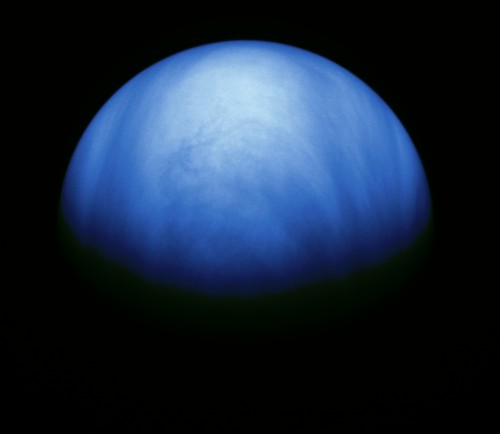Launched on August 27, 1962, Mariner II carried the following experiments intended for use at Venus (other instruments also took measurements of interplanetary space while enroute):
- Microwave radiometer - meant to determine the temperature of the planet's surface and details concerning the atmosphere.
- Infrared radiometer - meant to determine the structure of the cloud layer, and temperature distributions at cloud altitudes.
- Magnetometer - meant to detect Venus' magnetic field
Mariner II arrived at its encounter point on December 14, almost four months after launch. Never intended to enter orbit or plunge into the Venusian clouds, the spacecraft began recording as much information as it could in the short time Venus would be in range (the spacecraft was moving at 6.743 km/s relative to Venus). A special command from Earth placed Mariner II in "encounter" mode, during which it transmitted all recorded data in real time. It passe within 34,854 km, and seven hours later, Mariner II returned to cruise mode to continue on in a heliocentric orbit. Communication was lost on January 3, 1963.
So what did we learn about Venus from Mariner II?
- The 19-mm microwave radiometer indicated roughly equal temperatures on the light and dark sides of the planet:
- dark side = 460° K
- terminator = 570° K
- light side = 400° K
- Near Venus, there was no indication of a magnetic field or of appreciable change in the solar plasma flux or the charged particle flux.
- The infrared radiometer measured atmospheric temperatures that are consistent with Earth-based observations (hovering around 230° K), and detected no significant difference between the light and dark sides of the planet.
- Mass of Venus: 4.87 x 10^24 kg (0.81485 of Earth)
REFERENCES:
Chase, S.C.; Kaplan, L.D.; Neugebauer, G. (1963) "The Mariner 2 Infrared Radiometer Experiment, Journal of Geophysical Research 68 (22): 6157–6169. (http://ntrs.nasa.gov/archive/nasa/casi.ntrs.nasa.gov/19640006050_1964006050.pdf)
NASA, Mariner-Venus 1962: Final Project Report, NASA SP-59, Washington, 1965 (http://ntrs.nasa.gov/archive/nasa/casi.ntrs.nasa.gov/19660005413_1966005413.pdf)
National Space Science Data Center: Mariner II. NASA web site (http://nssdc.gsfc.nasa.gov/nmc/spacecraftDisplay.do?id=1962-041A)
Sonett, C. P. (1963). "A summary review of the scientific findings of the mariner venus mission." Space Science Reviews, 2(6), 751-777.
Chase, S.C.; Kaplan, L.D.; Neugebauer, G. (1963) "The Mariner 2 Infrared Radiometer Experiment, Journal of Geophysical Research 68 (22): 6157–6169. (http://ntrs.nasa.gov/archive/nasa/casi.ntrs.nasa.gov/19640006050_1964006050.pdf)
NASA, Mariner-Venus 1962: Final Project Report, NASA SP-59, Washington, 1965 (http://ntrs.nasa.gov/archive/nasa/casi.ntrs.nasa.gov/19660005413_1966005413.pdf)
National Space Science Data Center: Mariner II. NASA web site (http://nssdc.gsfc.nasa.gov/nmc/spacecraftDisplay.do?id=1962-041A)
Sonett, C. P. (1963). "A summary review of the scientific findings of the mariner venus mission." Space Science Reviews, 2(6), 751-777.


